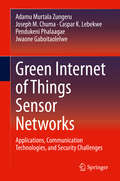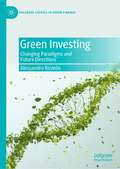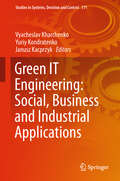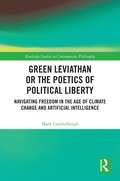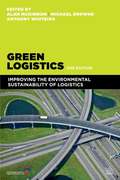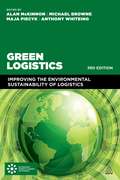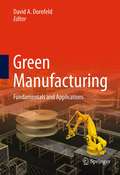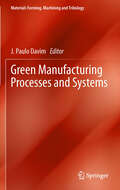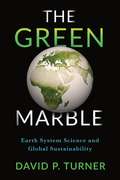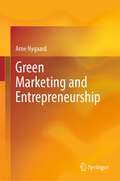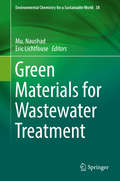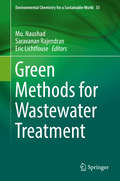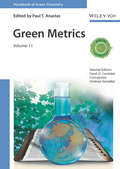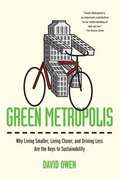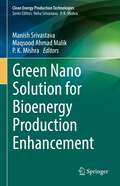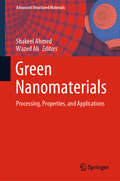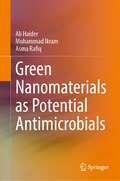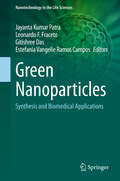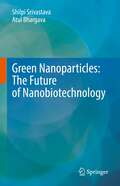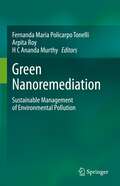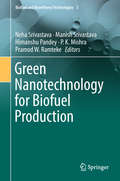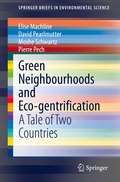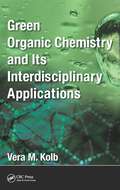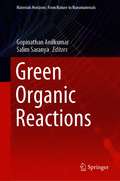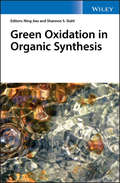- Table View
- List View
Green Internet of Things Sensor Networks: Applications, Communication Technologies, and Security Challenges
by Adamu Murtala Zungeru Joseph M. Chuma Caspar K. Lebekwe Pendukeni Phalaagae Jwaone GaboitaolelweThis book presents methods for advancing green IoT sensor networks and IoT devices. Three main methods presented are: a standalone system to support IoT devices that is informed by the amount of energy the solar array system can produce; a model of securing a building's main power supply against unauthorized use; and security of the IoT devices and their networks. For each, the authors outline the methods, presents security and privacy issues, and their solutions. The work suggests a layered approach to expose security issues and challenges at each layer of the IoT architecture and proposes techniques used to mitigate these challenges. Finally, perspectives are drawn and discussed for future directions in securing IoT sensor networks, covering evolving areas such as artificial intelligence, blockchain technology, sensor Internet of People, context-aware sensing, cloud infrastructure, security and privacy, and the Internet of Everything.
Green Investing: Changing Paradigms and Future Directions (Palgrave Studies in Impact Finance)
by Alessandro RizzelloThis book provides a unique picture of green finance by highlighting, under both theoretical and practical lenses, current changing paradigms and future directions in this field. The book is founded upon four major aspects that characterize current debates in green finance: products and services, financial innovation, green washing and transparency, and external pressures. The book is particularly useful to understand the current perimeter of the field; identify the potentials and challenges of the sector; explore current changing paradigms and its potentials to act as drivers for mainstreaming green finance; and conceptualize future directions of the field, with particular focus on its role in the post-COVID recovery plans. The book therefore is not only useful for deriving theoretical or practical implications for researchers and policy makers, but also to capture the evolving complexity of the field at the eve of extraordinary and green-driven changes in financial industry and in policy programs. The book also opens up interesting questions on theoretical advances in financial theory derived from these innovations and accelerated by the pandemic. It will be of interest to scholars and students from different academic disciplines such as economics, finance, political science, and entrepreneurship, as well as practitioners interested in green finance and in the financing of environmentally impactful organizations and projects.
Green IT Engineering: Social, Business and Industrial Applications (Studies in Systems, Decision and Control #171)
by Vyacheslav Kharchenko Yuriy Kondratenko Janusz KacprzykThis book describes the implementation of green IT in various human and industrial domains. Consisting of four sections: “Development and Optimization of Green IT”, “Modelling and Experiments with Green IT Systems”, “Industry and Transport Green IT Systems”, “Social, Educational and Business Aspects of Green IT”, it presents results in two areas – the green components, networks, cloud and IoT systems and infrastructures; and the industry, business, social and education domains. It discusses hot topics such as programmable embedded and mobile systems, sustainable software and data centers, Internet servicing and cyber social computing, assurance cases and lightweight cryptography in context of green IT. Intended for university students, lecturers and researchers who are interested in power saving and sustainable computing, the book also appeals to engineers and managers of companies that develop and implement energy efficient IT applications.
Green Leviathan or the Poetics of Political Liberty: Navigating Freedom in the Age of Climate Change and Artificial Intelligence (Routledge Studies in Contemporary Philosophy)
by Mark CoeckelberghThis book discusses the problem of freedom and the limits of liberalism considering the challenges of governing climate change and artificial intelligence (AI). It mobilizes resources from political philosophy to make an original argument about the future of technology and the environment. Can artificial intelligence save the planet? And does that mean we will have to give up our political freedom? Stretching the meaning of freedom but steering away from authoritarian options, this book proposes that, next to using other principles such as justice and equality and taking collective action and cooperating at a global level, we adopt a positive and relational conception of freedom that creates better conditions for human and non-human flourishing. In contrast to easy libertarianism and arrogant techno-solutionism, this offers a less symptomatic treatment of the global crises we face and gives technologies such as AI a role in the gathering of a new, more inclusive political collective and the ongoing participative making of new common worlds. Written in a clear and accessible style, Green Leviathan or the Poetics of Political Liberty will appeal to researchers and students working in political philosophy, environmental philosophy, and the philosophy of technology.
Green Logistics: Improving the Environmental Sustainability of Logistics
by Anthony Whiteing Alan Mckinnon Michael BrowneAs concern for the environment rises, companies must take more account of the external costs of logistics associated mainly with climate change, air pollution, noise, vibration and accidents. Green Logistics analyses the environmental consequences of logistics and how to deal with them. Written by a leading team of logistics academics, the book examines ways of reducing these externalities and achieving a more sustainable balance between economic, environmental and social objectives. It examines key areas in this important subject including: carbon auditing of supply chains; transferring freight to greener transport modes; reducing the environmental impact of warehousing; improving fuel efficiency in freight transport; reverse logistics for the management of waste. The new edition is completely updated throughout with new methodologies and case studies to illustrate the impact of green logistics in practice.
Green Logistics (Third Edition)
by Maja Piecyk Michael Browne Alan Mckinnon Anthony WhiteingAs concern for the environment rises, companies must take more account of the external costs of logistics associated mainly with climate change, air pollution, noise, vibration and accidents. Leading the way in current thinking on environmental logistics, Green Logistics provides a unique insight on the environmental aspects of logistics. Edited by a leading team of academics with contributions from global industry leaders and researchers, it examines key issues facing the logistics industry today. Fully updated and revised, the 3rd Edition takes a more global perspective. It introduces new contributors and insightful international case studies that illustrate the impact of green logistics in practice. There is a new chapter on green hinterland logistics considering port and maritime issues written by Jean-Paul Rodrigue and Adolf Ng and four postscripts written by the editors on hot topics in the field. Ideal for use on related courses, the 3rd Edition includes indispensable online supporting materials as well as technical information and guidelines for teachers and lecturers. The book is endorsed by the Chartered Institute of Logistics and Transport (CILT).
Green Manufacturing
by David A. DornfeldGreen Manufacturing: Fundamentals and Applications introduces the basic definitions and issues surrounding green manufacturing at the process,machine and system (including supply chain) levels. It also shows, by way of several examples from different industry sectors, the potential for substantial improvement and the paths to achieve the improvement. Additionally, this book discusses regulatory and government motivations for green manufacturing and outlines the path for making manufacturing more green as well as making production more sustainable.
Green Manufacturing Processes and Systems
by Paulo Davim JThis book provides the recent advances on green manufacturing processes and systems for modern industry. Chapter 1 provides information on sustainable manufacturing through environmentally-friendly machining. Chapter 2 is dedicated to environmentally-friendly machining: vegetable based cutting fluids. Chapter 3 describes environmental-friendly joining of tubes. Chapter 4 contains information on concepts, methods and strategies for zero-waste in manufacturing. Finally, chapter 5 is dedicated to the application of hybrid MCDM approach for selecting the best tyre recycling process. This book serves as a research book for students at final undergraduate engineering course or at postgraduate level. It is a reference for professionals in industries related to manufacturing and new green jobs (green products, renewable energy, green services and environmental conservation).
The Green Marble: Earth System Science and Global Sustainability
by David TurnerHumans have difficulty thinking at the global scale. Yet as we come to understand our planet as a single, interconnected, complex system and encounter compelling evidence of human impact on Earth’s climate and biosphere, the need for a truly global effort is increasingly urgent. In this concise and accessible text, David P. Turner presents an overview of global environmental change and a synthesis of research and ideas from the rapidly evolving fields of earth system science and sustainability science that is suitable for anyone interested in humanity’s current predicaments and what we can do about them.The Green Marble examines Earth’s past, contemporary human disruption, and the prospects for global environmental governance. Turner emphasizes the functioning of the biosphere—the totality of life on Earth—including its influence on geologic history, its sensitivity to human impacts, and its possible role in ameliorating climate change. Relying on models of the earth system that synthesize vast amounts of monitoring information and recent research on biophysical processes, The Green Marble describes a range of scenarios for our planetary home, exploring the effects of anthropogenic greenhouse gas emissions and factors such as economic globalization. Turner juxtaposes cutting-edge ideas from both the geosciences and the social sciences to illustrate how humanity has arrived upon its current dangerous trajectory, and how we might pull back from the brink of civilization-challenging environmental change. Growing out of the author’s popular course on global environmental change, The Green Marble is accessible to non-science majors and provides a framework for understanding the complex relationship of humanity to the global environment.
Green Marketing and Entrepreneurship
by Arne NygaardThis comprehensive book reveals the intricate interplay between entrepreneurship, strategy, and marketing management in the context of sustainability. The book champions the green shift within businesses and organizations, equipping both companies and consumers with the knowledge needed to make well-informed decisions that drive positive market transformations. Providing a holistic understanding of sustainable and disruptive change processes for students and professionals, it looks into a spectrum of powerful strategies, ranging from green marketing approaches and segmentation techniques to the nuances of demarketing and green branding. Readers will uncover the critical role of companies and decision-makers in reshaping consumer behavior and supply chains, while navigating potential pitfalls like the "tragedy of the commons" and "greenwashing." Furthermore, they will gain valuable insights into how strategic positioning and targeted efforts can yield sustainable outcomes and increase consumer willingness to invest in environmentally conscious products. Green Marketing and Entrepreneurship allows readers to explore the profound impact of marketing strategies on the delicate balance of nature and discover actionable green marketing methodologies that can pave the way for a more sustainable and environmentally conscious world.
Green Materials for Wastewater Treatment (Environmental Chemistry for a Sustainable World #38)
by Mu. Naushad Eric LichtfouseThis book reviews health hazards associated with wastewater use and water pollutants. Chapters present applications of green materials made of agricultural waste, activated carbon and magnetic materials for wastewater treatment. The removal of toxic metals using algal biomass and the removal of toxic dyes using chitosan composite materials are also discussed. The book includes reviews on the removal of phenols, pesticides, and on the use of ionic liquid-modified activated carbon for the treatment of textile wastewater.
Green Methods for Wastewater Treatment (Environmental Chemistry for a Sustainable World #35)
by Mu. Naushad Saravanan Rajendran Eric LichtfouseThis book presents comprehensive chapters on the latest research and applications in wastewater treatment using green technologies. Topics include mesoporous materials, TiO2 nanocomposites and magnetic nanoparticles, the role of catalysts, treatment methods such as photo-Fenton, photocatalysis, electrochemistry and adsorption, and anti-bacterial solutions. This book will be useful for chemical engineers, environmental scientists, analytical chemists, materials scientists and researchers.
Green Metrics
by Paul T. Anastas David J. Constable Concepcion Jimenez GonzalesThere has been dramatic growth in the community of researchers and industrialists working in the area of Green Chemistry. There has been an increasing recognition by a wide-range of scientists and engineers in the chemical enterprise that the framework of Green Chemistry is relevant and enabling to their work. There has been a significant body of work that has accumulated over the past decade that details the breakthroughs, innovation and creativity within Green Chemistry and Engineering. While there have been edited volumes on Green Chemistry that collect a limited number of papers often on a particular topic area, there is not currently a series that seeks to provide a more comprehensive overview of the current state of the science. The lack of this type of series is a notable niche for which the continually growing Green Chemistry and engineering community would value and welcome.
Green Metropolis: Why Living Smaller, Living Closer, and Driving Less Are the Keys to Sustainability
by David OwenIn this remarkable challenge to conventional thinking about the environment, David Owen argues that the greenest community in the United States is not Portland, Oregon, or Snowmass, Colorado, but New York, New York. Most Americans think of crowded cities as ecological nightmares, as wastelands of concrete and garbage and diesel fumes and traffic jams. Yet residents of compact urban centers, Owen shows, individually consume less oil, electricity, and water than other Americans. They live in smaller spaces, discard less trash, and, most important of all, spend far less time in automobiles. Residents of Manhattan- the most densely populated place in North America -rank first in public-transit use and last in percapita greenhouse-gas production, and they consume gasoline at a rate that the country as a whole hasn't matched since the mid-1920s, when the most widely owned car in the United States was the Ford Model T. They are also among the only people in the United States for whom walking is still an important means of daily transportation. These achievements are not accidents. Spreading people thinly across the countryside may make them feel green, but it doesn't reduce the damage they do to the environment. In fact, it increases the damage, while also making the problems they cause harder to see and to address. Owen contends that the environmental problem we face, at the current stage of our assault on the world's nonrenewable resources, is not how to make teeming cities more like the pristine countryside. The problem is how to make other settled places more like Manhattan, whose residents presently come closer than any other Americans to meeting environmental goals that all of us, eventually, will have to come to terms with.
Green Nano Solution for Bioenergy Production Enhancement (Clean Energy Production Technologies)
by Manish Srivastava Maqsood Ahmad Malik P. K. MishraThis edited book presents nanotechnology-based approaches to improve quality of biofuels production. It covers the use of different nanomaterials in various biofuels production methods and their sustainable utility analysis to improve production of biofuels at economical and mass scale. Environmentally friendly, low cost, and synthesis via green and renewable resources are the main key features covered by this book. Advantages and sustainability scope of green and renewable material to synthesize nanomaterial and reduction in synthesis cost over to chemical synthesis cost have been discussed in this book. The book also explores various green synthesis possibilities to synthesize nanomaterials that are frequently involved in biofuels production process as catalysts. Various feasible mechanisms have also been explained. Maximum and sustainable use of green nanomaterials at every step of biofuels production is also one of the major focuses of this book. It covers mega audiences, which include academician, researchers, and industries people. This book will be highly interesting for researchers and scientists as well as related industries.
Green Nanomaterials: Processing, Properties, and Applications (Advanced Structured Materials #126)
by Shakeel Ahmed Wazed AliThis book comprises a collection of chapters on advances in green nanomaterials. The book looks at ways to establish long‐term safe and sustainable forms of nanotechnology through implementation of nanoparticle biosynthesis with minimum impact on the ecosystem. The book looks at synthesis, processing, and applications of metal and metal oxide nanomaterials and also at bio-nanomaterials. The contents of this book will prove useful for researchers and professionals working in the field of nanomaterials and green technology.
Green Nanomaterials as Potential Antimicrobials
by Ali Haider Muhammad Ikram Asma RafiqThis book focuses on nanomaterials with antibacterial properties. Antibacterial resistance is a growing concern that poses a serious threat to public health worldwide. This book looks at the fabrication, material's properties, and characterization of a range of metallic, bimetallic, and metal-oxide-based nanomaterials that can be exploited for their antimicrobial properties. A key focus of this book is its emphasis on ‘green’ synthesis of nanomaterials, as many conventional routes of nanomaterial fabrication do not fulfill key sustainability criteria in terms of their toxicity and lack of eco-friendliness. Additionally, this book introduces the application of nanoparticles to veterinary medicine. Given the ever-increasing global livestock population coupled with the emergence of drug-resistant pathogens of animal origin (bacterial, parasitic, and hemoprotozoa), the use of nanoparticles as antibacterial agents represents a paradigm shift in every aspect of veterinary care. Authored by scholars with combined expertise in nanomaterials and veterinary medicine, this book provides valuable information for researchers working on sustainable nanomaterials with antibacterial properties.
Green Nanoparticles: Synthesis and Biomedical Applications (Nanotechnology in the Life Sciences)
by Jayanta Kumar Patra Gitishree Das Leonardo F. Fraceto Estefania Vangelie Ramos CamposNanotechnology is the application of science to control matter at the molecular level. It has become one of the most promising applied technologies in all areas of science. Nanoparticles have multi-functional properties and have created very interesting applications in various fields such as medicine, nutrition, bioenergy, agriculture and the environment. But the biogenic syntheses of monodispersed nanoparticles with specific sizes and shapes have been a challenge in biomaterial science. Nanoparticles are of great interest due to their extremely small size and large surface-to-volume ratio, which lead to both chemical and physical differences in their properties (e.g., mechanical properties, biological and sterical properties, catalytic activity, thermal and electrical conductivity, optical absorption and melting point) compared to bulk of the same chemical composition. Recently, however, synthesizing metal nanoparticles using green technology via microorganisms, plants, viruses, and so on, has been extensively studied and has become recognized as a green and efficient way for further exploiting biological systems as convenient nanofactories. Thus the biological synthesis of nanoparticles is increasingly regarded as a rapid, ecofriendly, and easily scaled-up technology. Today researchers are developing new techniques and materials using nanotechnology that may be suitable for plants to boost their native functions. Recently, biological nanoparticles were found to be more pharmacologically active than physico-chemically synthesized nanoparticles. Various applications of biosynthesized nanoparticles have been discovered, especially in the field of biomedical research, such as applications to specific delivery of drugs, use for tumor detection, angiogenesis, genetic disease and genetic disorder diagnosis, photoimaging, and photothermal therapy. Further, iron oxide nanoparticles have been applied to cancer therapy, hyperthermia, drug delivery, tissue repair, cell labeling, targeting and immunoassays, detoxification of biological fluids, magnetic resonance imaging, and magnetically responsive drug delivery therapy. Nanoparticle synthesis for plant byproducts for biomedical applications has vast potential. This book offers researchers in plant science and biomedicine the latest research and opportunity to develop new tools for the synthesis of environmentally friendly and cost-effective nanoparticles for applications in biomedicine as well as other various fields.
Green Nanoparticles: The Future of Nanobiotechnology
by Shilpi Srivastava Atul BhargavaThis book discusses the fundamental concepts of the green synthesis of nanoparticles and presents the latest advances in this emerging field. Providing a comprehensive overview of developments related to nanoparticle synthesis using fungi, algae, bryophytes, pteridophytes, gymnosperms, monocotyledons, dicotyledonous (angiosperms) and animal systems, it also explores techniques for the characterization of these nanoparticles. Lastly, it reviews the applications and toxicity of biologically synthesized green nanoparticles. Given its scope, it is a valuable resource for students, researchers and policymakers working in the field of nanobiotechnology and nanoscience.
Green Nanoremediation: Sustainable Management of Environmental Pollution
by Fernanda Maria Policarpo Tonelli Arpita Roy H. C. Ananda MurthyThis book focuses on green nanoremediation addressing aspects related to the use of nanomaterials generated through green synthesis protocols to efficiently restore polluted environs. Nanomaterials’ characteristics such as large surface area, capacity to easily reach into contaminated sites, good reactivity, and possibility of being developed to present photocatalytic activity and/or to deal with targeted substances by chemical surface modification are useful specially to perform remediation. As an alternative to conventional physicochemical methods, the green-based synthesis protocols reject the use of harmful reagents, prevent waste production, apply renewable energy source and/or materials, and consider in first place offering the smallest negative impact possible to living beings and to the ecosystem. Green synthesis in nanotechnology field involves the use of seaweeds, bacteria, cyanobacteria, yeasts, fungi, plants (living ones, biomass, extracts) and/or bio-derived products to generate the nanomaterials. The introductory chapter will be dedicated to nanomaterials’ characteristics that enable them to be used in environmental remediation. The first part of the book will be dedicated to organic and inorganic pollution and the threats they pose to living forms; advantages, disadvantages and mechanisms of nanoremediation; comparison between conventional strategies of environmental pollution remediation and the green nanoremediation; carbon-based and non-carbon-based green nanomaterials capable of promoting environs’ remediation; cost/benefits of using nanomaterials and nanoinformatics to a safe nanotechnology. The second part will be dedicated to green nanoremediation of water and soil, microbe-based, algae-based and plant-based synthesis of nanomaterials to nanoremediation. This part will also contain chapters dedicated to relevant nanomaterials for green nanoremediation protocols, nano-phytoremediation strategies, strategies to evaluate the efficiency of protocols related to this kind of remediation, main interactions of green nanomaterials and microbes during nanoremediation and, as a consequence of it, biocompatibility of green nanomaterials. This book’s main purpose is to offer readers extensive knowledge on green nanoremediation as a feasible strategy to fight pollution's harmful consequences and clean environmental pollution, but also present the challenges that should be surpassed.
Green Nanotechnology for Biofuel Production (Biofuel and Biorefinery Technologies #5)
by Pramod W. Ramteke P. K. Mishra Himanshu Pandey Manish Srivastava Neha SrivastavaThis book focuses on the use of nanotechnology and nanomaterials in the production of biofuels. It describes the current production technologies for different biofuels and their limitations for commercialization, and discusses in detail how nanomaterials could reduce biofuel production costs. After an introduction to biofuels, the book examines biofuels economics and policy; biofuel production processes – advances and limitations; nanotechnology and its energy applications; nanotechnology in biohydrogen production – for cellulases, in algal fuel, and in bioethanol/biobutanol and biodiesel production. It is a valuable resource for researchers and engineers.
Green Neighbourhoods and Eco-gentrification: A Tale of Two Countries (SpringerBriefs in Environmental Science)
by Elise Machline David Pearlmutter Moshe Schwartz Pierre PechThis SpringerBrief brings together a series of studies that delve into the details of French and Israeli green building practices and tell a tale of two countries which deviates considerably from what first impressions might suggest. In-depth data analysis, interviews with stakeholders, and on-the-ground documentation are used to paint a portrait of green neighborhoods in both large and small cities, and to shed light on the diversity of outcomes and the intricate web of interests leading to each one.In the Israeli cases, these dynamics reflect the fact that the private sector has become increasingly dominant in the residential building field, following a decades-long process in which the welfare state has shrunk, and the government has distanced itself from large social programs.The French solution to this dilemma is to mandate the inclusion of subsidized housing within its ecoquartiers, with the declared aim of promoting a diverse 'social mix' of population.Green building has yet to prove itself as a solution for the masses. The sale price of an apartment in a certified green building is significantly higher than what would be justified by either the additional construction costs required to build it, or the energy and water saving potential that can be realized by using it. The tale of two countries presented here suggests that neither the mechanisms of the market nor the proclamations of a welfare state can easily overcome this dilemma. What is needed is a new type of thinking, which can only emerge once the concept of "value" reflects not only the realities of a free-market economy, but also those of a planet which turns out to be distinctly limited in its resources.
Green Organic Chemistry and its Interdisciplinary Applications
by Vera M. KolbGreen Organic Chemistry and Its Interdisciplinary Applications covers key developments in green chemistry and demonstrates to students that the developments were most often the result of innovative thinking. Using a set of selected experiments, all of which have been performed in the laboratory with undergraduate students, it demonstrates how to optimize and develop green experiments. The book dedicates each chapter to individual applications, such as Engineering The chemical industry The pharmaceutical industry Analytical chemistry Environmental chemistry Each chapter also poses questions at the end, with the answers included. By focusing on both the interdisciplinary applications of green chemistry and the innovative thinking that has produced new developments in the field, this book manages to present two key messages in a manner where they reinforce each other. It provides a single and concise reference for chemists, instructors, and students for learning about green organic chemistry and its great and ever-expanding number of applications.
Green Organic Reactions (Materials Horizons: From Nature to Nanomaterials)
by Gopinathan Anilkumar Salim SaranyaThis book presents important developments and applications of green chemistry, especially in the field of organic chemistry. The chapters give a brief account of green organic reactions in water, green organic reactions using microwave and in solvent-free conditions. In depth discussions on the green aspects of ionic liquids, flow reactions, and recoverable catalysts are provided in this book. An exclusive chapter devoted to green Lewis acid is also included. The potential of supercritical fluids as green solvents in various areas of organic reactions is explained as well. This book will be a valuable reference for beginners as well as advanced researchers interested in green organic chemistry.
Green Oxidation in Organic Synthesis
by Ning Jiao Shannon S. StahlA valuable introduction to green oxidation for organic chemists interested in discovering new strategies and new reactions for oxidative synthesis Green Oxidation in Organic Synthesis provides a comprehensive introduction and overview of chemical preparation by green oxidative processes, an entry point to the growing journal literature on green oxidation in organic synthesis. It discusses both experimental and theoretical approaches for the study of new catalysts and methods for catalytic oxidation and selective oxidation. The book highlights the discovery of new reactions and catalysts in recent years, discussing mechanistic insights into the green oxidative processes, as well as applications in organic synthesis with significant potential to have a major impact in academia and industry. Chapters are organized according to the functional groups generated in the reactions, presenting interesting achievements for functional group formation by green oxidative processes with O2, H2O2, photocatalytic oxidation, electrochemical oxidation, and enzymatic oxidation. The mechanisms of these novel transformations clearly illustrated. Green Oxidation in Organic Synthesis will serve as an excellent reference for organic chemists interested in discovering new strategies for oxidative synthesis which address the priorities of green and sustainable chemistry.
